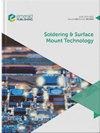Sn-9.0 wt.% Zn/Cu-Ti合金(C1990 HP)偶联界面反应
IF 1.8
4区 材料科学
Q3 ENGINEERING, ELECTRICAL & ELECTRONIC
引用次数: 0
摘要
本研究的目的是利用液固反应偶联技术,研究在cu基合金中加入少量Ti对其与Sn-9.0 wt.% Zn (SnZn)焊料界面反应的影响,特别是在含有Cu-3.28 wt.% Ti的商用超钛铜合金(C1990 HP)中。设计/方法/方法将SnZn/C1990 HP偶体在240 ~ 270℃的反应温度下反应0.5 ~ 5 h,利用扫描电镜、能谱仪、电子探针微量分析仪和x射线衍射仪对反应偶体进行表征。发现几乎所有SnZn/C1990 HP对均形成扇形CuZn5和平面Cu5Zn8相。随着反应时间的延长和反应温度的升高,富cu金属间化合物(IMC)-Cu5Zn8相成为界面形成的主要IMC相。随着反应时间和温度的增加,IMCs的总厚度增加。IMC生长服从抛物线规律,IMC生长机制受扩散控制。SnZn/C1990 HP对的活化能为64.71 kJ/mol。本文利用ImageJ软件分析了每个样品的IMC厚度,然后用Origin软件分析了SnZn/C1990 HP在不同反应温度下的液/固耦合动力学。该研究还包括详细的形貌报告,界面组成和x射线衍射分析,以及活化能。研究结果可为使用C1990 HP基板的电子封装公司提供有价值的参考。本文章由计算机程序翻译,如有差异,请以英文原文为准。
Interfacial reactions in the Sn-9.0 wt.% Zn/Cu-Ti alloy (C1990 HP) couple
Purpose The purpose of this study was to examine the influence of adding a small amount of Ti to a Cu-based alloy, specifically the commercial Hyper Titanium Copper alloy (C1990 HP), which contains Cu-3.28 wt.% Ti, on its interfacial reaction with Sn-9.0 wt.% Zn (SnZn) solder, using the liquid/solid reaction couple technique. Design/methodology/approach The SnZn/C1990 HP couples were subjected to a reaction temperature of 240–270°C for a duration of 0.5–5 h. The resulting reaction couple was characterized using a scanning electron microscope, energy dispersive spectrometer, electron probe microanalyzer and X-ray diffractometer. Findings It was observed that the scallop-shaped CuZn5 and planar Cu5Zn8 phases were formed in almost all SnZn/C1990 HP couples. With increased reaction duration and temperature, the Cu-rich intermetallic compound (IMC)-Cu5Zn8 phase became a dominant IMC formed at the interface. The total thickness of the IMCs was increased with the increase in the reaction duration and temperature. The IMC growth obeyed the parabolic law, and the IMC growth mechanism was diffusion controlled. The activation energy of the SnZn/C1990 HP couple was 64.71 kJ/mol. Originality/value This article presents an analysis of the IMC thickness in each sample using ImageJ software, followed by kinetic analysis using Origin software at various reaction temperatures of SnZn/C1990 HP in liquid/solid couples. The study also includes detailed reports on the morphology, interface composition and X-ray diffraction analysis, as well as the activation energy. The findings can serve as a valuable reference for electronic packaging companies that utilize C1990 HP substrates.
求助全文
通过发布文献求助,成功后即可免费获取论文全文。
去求助
来源期刊

Soldering & Surface Mount Technology
工程技术-材料科学:综合
CiteScore
4.10
自引率
15.00%
发文量
30
审稿时长
>12 weeks
期刊介绍:
Soldering & Surface Mount Technology seeks to make an important contribution to the advancement of research and application within the technical body of knowledge and expertise in this vital area. Soldering & Surface Mount Technology compliments its sister publications; Circuit World and Microelectronics International.
The journal covers all aspects of SMT from alloys, pastes and fluxes, to reliability and environmental effects, and is currently providing an important dissemination route for new knowledge on lead-free solders and processes. The journal comprises a multidisciplinary study of the key materials and technologies used to assemble state of the art functional electronic devices. The key focus is on assembling devices and interconnecting components via soldering, whilst also embracing a broad range of related approaches.
 求助内容:
求助内容: 应助结果提醒方式:
应助结果提醒方式:


